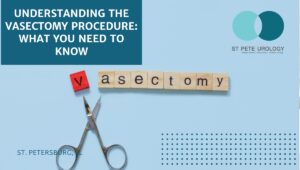Key Takeaways:
1. A vasectomy is a permanent form of contraception for men that prevents pregnancy by blocking the flow of sperm from the testicles to the penis.
2. Preparation for a vasectomy includes discussing potential risks and complications with a doctor, scheduling an appointment at a certified facility and undergoing pre-surgery testing.
3. After the surgery, patients should expect minor pain and swelling, use an alternate form of contraception until the procedure is confirmed successful, and follow-up care with their doctor.
 Understanding the Vasectomy Procedure: What You Need to Know
Understanding the Vasectomy Procedure: What You Need to Know
A vasectomy is a permanent form of contraception for men that prevents pregnancy by blocking the flow of sperm from the testicles to the penis. Though the procedure is relatively safe, with proper tools and techniques it is important to understand what is involved. This article aims to provide an overview of the vasectomy procedure and explain the reasons for considering this option. It will also detail what is involved in preparation, surgery, and recovery.
Introduction
A vasectomy is a routine and relatively safe procedure that involves blocking the flow of sperm from the testicles to the penis, making it an extremely effective form of contraception. Men considering the procedure should understand the risks and benefits associated with the procedure, and make sure to discuss the specifics with their doctor.
Overview of the Vasectomy Procedure
A vasectomy is a surgical procedure that is performed under local anesthesia and is relatively quick and simple. During the procedure, a surgeon can access the tubes that transport sperm from the testes to the penis. They use clamps, heat, or a cauterizing device to cut and seal these tubes. Vasectomy does not interfere with male hormones or with the appearance of the patient’s external genitalia. However, it does not protect against sexually transmitted diseases.
Reasons for Considering a Vasectomy
Men may consider having a vasectomy for personal, finance, or medical reasons. If smaller families are desired, couples may consider a vasectomy. They might choose this option if they are sure they do not want any more children. Additionally, a vasectomy may be recommended if a medical condition, such as a genetic disorder, increases the risk of having a baby with birth defects.
In addition, vasectomy is much less expensive than other contraceptive methods such as tubal ligation. So, couples may decide it is the best option to meet their needs.
Description of the Vasectomy Procedure
What Is Involved in the Procedure?
The vasectomy procedure typically takes no more than 30 minutes and is performed in an outpatient setting. During the procedure, the surgeon anesthetizes the scrotum and cuts the connecting tubes through which sperm travels. These tubes are then sealed using heat or clamps and the scrotal incision is closed using sutures.
Once the procedure is completed, the sperm are still present in the seminal vesicles and ejaculatory ducts, but can no longer travel to the penis, making the patient infertile.
Side Effects and Complications
While a vasectomy is generally a safe and relatively simple procedure, as with any medical procedure there are always potential risks or complications. The most common complication is post-vasectomy pain syndrome, which usually subsides within a few months. Other complications include infection, pain, swelling, and bruising.
What to Expect Following the Surgery
Immediately following the procedure, pain, swelling, and bruising may occur, but typically subsides within a few days. Generally, patients can return to work within a few days, but heavy lifting or strenuous activity should be avoided for 1-2 weeks. Sexual activity can usually resume soon after the procedure, however, it is important to use another form of contraception until the doctor confirms that the procedure was successful.
Preparing for a Vasectomy
What to Discuss with Your Doctor
Prior to scheduling the procedure, it is important to have a thorough and informative conversation with your doctor. This discussion should cover the risks and complications associated with the procedure and any underlying medical conditions that could affect the surgery. Your doctor should also provide detailed instructions about preparation for the procedure and what to expect afterwards.
Scheduling Your Appointment
Patients should schedule the procedure at a facility that is certified to perform such operations. It is also important to allow enough time for all tests and consultations that may be necessary prior to the surgery.
Pre-Surgery Testing
Your doctor may require you to have additional testing done, such as a urine test, complete blood count, and a semen analysis. These tests are done to make sure the patient is in good health and has the correct hardware that is needed for a successful surgery.
What to do and Not do Before and After the Procedure
Before the surgery, it is important to plan ahead. Make sure to have someone available to drive you home after the procedure, and make arrangements to take a few days off work to allow time for recovery. Additionally, patients should avoid alcohol for two days before the surgery, and avoid any strenuous activity for several days afterwards.
Aftercare and Recovery
Expected Recovery Time
Recovery from a vasectomy typically takes a few days and includes minor pain and swelling. Pain typically subsides within a few days and patients are usually able to resume most activities within a week.
Follow-up Care
It is common for patients to experience some residual swelling and flesh colored lumps around the scrotum for up to six weeks. Your doctor may also ask you to provide a semen sample three months after the procedure to make sure the tubes remain blocked.
How to Make Sure the Procedure Was Successful
It is important to use another form of contraception until a semen sample confirms that the procedure was successful. If a sperm sample is not produced six weeks after the operation, your doctor may recommend another semen sample at three months post-surgery.
When Is It Safe to Resume Sexual Activity?
Typically, sexual activity can resume soon after the surgery. However, it is important to use an alternate form of contraception until the doctor confirms that the procedure was successful.
Conclusion
A vasectomy is a highly effective form of contraception for men and is a safe and routine procedure. Prior to scheduling the procedure, it is important to talk to your doctor in order to receive instructions and advice on preparation, surgery, and recovery. With proper aftercare and follow-up care, the procedure can be successful and help couples reach their family planning goals.
For more information or to schedule an appointment to discuss the vasectomy procedure, visit St Pete Urology. We are a urology practice located in St Petersburg, Florida, dedicated to providing the highest quality of care and specialized treatment for our patients.
Sources:
- “Vasectomy: Surgery Overview.” Cleveland Clinic, 19 March 2018, https://my.clevelandclinic.org/health/treatments/4423-vasectomy.
- Guzzo, Thomas J. “5 Reasons to Consider a Vasectomy.” Best Urology Clinic, 11 March 2021, https://www.besturologyclinic.com/blog/5-reasons-to-consider-a-vasectomy.
- “Vasectomy.” Eunice Kennedy Shriver National Institute of Child Health and Human Development, National Institutes of Health, U.S. Department of Health and Human Services, 7 September 2021, https://www.nichd.nih.gov/health/topics/vasectomy/conditioninfo/.





